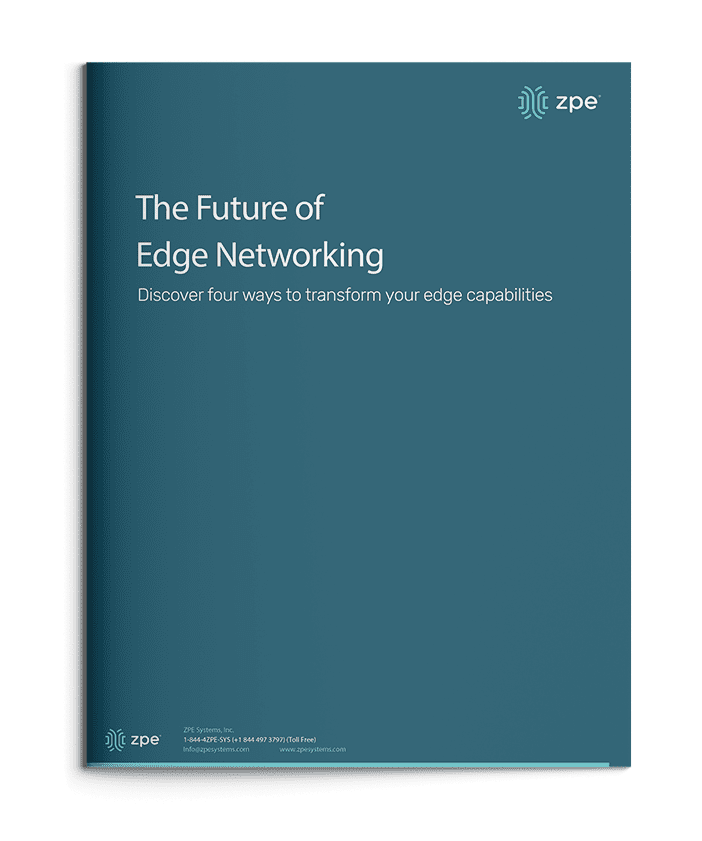We’re entering the era of edge networking
Edge networking is critical to the future. Organizations continue to expand, and analysts predict that the data center won’t be the only workhorse when it comes to enterprise networking. In fact, some estimate that in a couple years, more than 50% of data will be generated outside the data center or cloud.
Continue reading to learn more about the edge, why it’s the future, and how you can address four key components of edge networking.
What is the ‘edge’?
The edge includes systems that are close to where end devices and third party services interact with your network. Think IoT cameras, self-service kiosks, mobile apps, POS systems, and other things that interact at the last mile of your network.
What is edge networking?
With increasing focus on the edge comes confusion. This stems from the fact that edge networking is typically seen as something completely different than edge computing. That’s because they are technically very different, even though they are part of the same space.
Think of a traditional enterprise network setup. You have the data center at the core, and then branch offices distributed across different locations.
- Edge networking refers to the tunnels that connect these branches to each other, to the data center, and to distributed cloud service applications.
- Edge computing means putting parts of the core, such as data processing, storage, load balancing, etc. at or nearer to these branches.
However, the lines are blurring between these two as they are increasingly implemented together. For the sake of this blog post, we’ll combine them and refer to both using one term: edge networking.
There’s a growing need for edge networking
If 2020 was any indication, you likely know firsthand about the growing need for better edge networking capabilities. You may even still struggle with recent changes. You have to make sure your widespread network can handle rapid shifts in customer demand. You also need to accommodate your staff, who are likely no longer working from centralized office locations but instead from home or on the go. Connectivity is more distributed than it’s ever been, and 2020 was a catalyst for this growing trend.
You’ve witnessed this shift in the real world and faced new challenges of traditional enterprise network configurations. This is because the legacy core-to-edge infrastructure was not designed for such widespread networking. If you haven’t already, you will eventually experience significant drawbacks if you don’t move toward more ‘edgified’ infrastructure and solutions.
- Drawback #1: Slowdowns — Imagine peak demand at your edge locations, and then multiply that by a factor of five, ten, or more. This is what the future has in store, and your traditional setup won’t be able to handle all of this data. With so much information flooding back to the core, your data center will become inundated trying to process it all. This means slowdowns, even catastrophic failures, that can take down both the customer experience and your staff’s ability to keep operations running.
- Drawback #2: Security breaches — The threat landscape is constantly evolving. With more edge connections comes a greater attack surface, and if you continue using traditional solutions, you’ll have to be constantly mindful of your network’s security. Vulnerabilities will present themselves with your physical devices, virtual assets, and integrations, each of which may allow for exploitation across your network. This will force you to spend monumental sums of time and money trying to protect your business and your customers.
- Drawback #3: Obsolete solutions — Edge networking is a young market, which means edge solutions will come and go. This volatility means you’ll need a network that can adapt fast, but traditional configurations are too rigid. If you standardize with one vendor’s solutions, you’re left locked into using only their offerings. This could easily leave you with obsolete solutions that will continue costing you.
These are just a few of the reasons why you need to adopt edge networking.
What does the future hold for edge networking?
Edge networking of the future will allow you to accommodate growing, constantly evolving requirements. But if you’re supposed to move away from the traditional setup, where the core consists of data center functions and the edge simply funnels data back to the core, what will networking look like?
- The edge will become the data center. Because there are increasing requirements for responsive edge experiences, processing will be placed near or at the edge. This will allow you to relieve your data center while optimizing distributed connections for customers and staff.
- Security will be built in. With an ever-growing network, you’ll have to accommodate more connections. Protecting your business and customer data will involve implementing security from the ground up. This will mean deploying hardware and software that will come with more built-in safeguards, and that will allow you to implement thorough protection through Zero Trust Security practices.
- You’ll be more adaptable than ever. A volatile solutions market will force you to continually adapt. The firewall that’s perfect one day might be obsolete the next, and the same will be true for SD-WAN, management, machine learning, and other solutions. The key to this flexibility will be in having an infrastructure that emphasizes extensibility and software-defined networking.
Do you want a head start on the future of edge networking?
Download our ebook, The Future of Edge Networking, and discover four ways you can achieve the network of the future.

